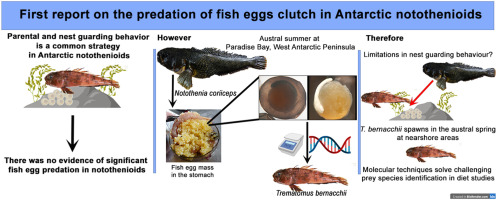Estuarine, Coastal and Shelf Science, Vol. 255, 05 March, 2022
Highlights
- First report on the predation of fish eggs clutch in Antarctic notothenioids.
- Molecular techniques solve challenging prey species identification in diet studies.
- Parental egg guarding strategy in notothenioid fishes shows potential limitations.
- Inshore sites serve as spawning grounds for Antarctic notothenioids.
Abstract
Parental care and nest guarding behaviors have been described for all major clades of Antarctic notothenioid fishes. In possible association with this reproductive behavior, there is no evidence of significant fish egg predation in notothenioids so far. Here, we report a recently ingested fish egg mass in the stomach of a large specimen of the voracious bullhead notothen Notothenia coriiceps caught in Paradise Bay, West Antarctic Peninsula, in mid-January 2019. Using molecular markers, the preyed eggs were identified as being emerald notothens Trematomus bernacchii, which enabled us to discuss aspects of the emerald notothen reproductive ecology. Our estimation of 4443 ingested eggs of 3.94 mm in average diameter, coupled with comparable literature data, suggested that this bullhead notothen ate the entire spawn. Based on an estimated age of the T. bernacchii embryos at 30 to 45 days post-fertilization, the spawning event likely occurred in December. Although it is known from a close location to our study site that emerald notothens use sponge cavities as spawning substrates with females guarding nests, we also recovered a small fragment of algae in the stomach content of the bullhead notothen, suggesting that the egg mass could have also been laid on algae. Our findings suggests that in this case of predator-prey interaction between two sympatric notothenioid species, there was a lack of effectiveness in egg protection, revealing a possible limit of egg guarding in the Antarctic ichthyofauna.
Notothenioidei

